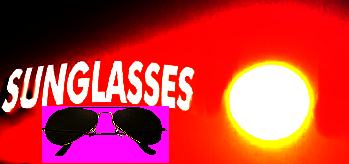

ARE SUNGLASSES IN AVIATION REALLY NECESSARY?
Van B. Nakagawara, O.D.
Kathryn J. Wood, Opt. T.,R.
|
A recent article in an aviation journal discussed the use of sunglasses by aviators, and specifically the use of Corning Optics' Serengeti sunglasses. Several statements in that article were contradictory, and flight surgeons and Aviation Medical Examiners may be queried by pilots on the use of such lenses. Several issues on the use of sunglasses should be reinforced to aviators, including: Sunglasses with light transmittance less than 15% may reduce effective Snellen visual acuity. Target detection and resolution, especially for visual targets of medium to low contrast, may also be degraded. Most Serengeti sunglasses, at their darkest shade, have less than 15% light transmittance. |
 |
All Serengeti lenses, except one, are photochromic and thus darken when exposed to ultraviolet light. Aircraft windscreen using polycarbonate materials may block ultraviolet light, reducing the protective quality of the lenses.
Also, since a darkened photochromic lens requires time to lighten, aviators may experience visual performance loss when flying into clouds or darkened mountain ranges. Polarized lenses eliminate reflected glare from a flat surface. However, looking through a laminated aircraft windscreen, while wearing polarized lenses, can result in a reduced retinal image. The Serengeti Strata lenses are polarized. Color discrimination may be reduced while wearing dark lenses. The minimum transmittance for red traffic signal light is 8%, and for green and yellow signal light is 6%.
Tinted lenses with transmittances below these values may render traffic signals undetectable at a reasonably safe stopping distance and are not recommended for daylight driving. At their darkest tint, most Serengeti sunglasses reduce light transmission by 8 to 14%.
However, at these transmission levels, a mildly color-deficient aviator may have difficulty in recognizing color signals, since the Serengeti lenses reduce blue, green, and red light transmittance. In fact, several of the Serengeti sunglasses are touted as blueblocking lenses that preserve contrast.l Blue-blocking lenses have been found to produce mild color discrimination losses in normal color vision subjects and severely reduce color discrimination in dichromatic (severe color deficient) subjects.
Sunglasses should not be worn at night. Light levels at night are critical to good vision. The Serengeti sunglasses only lighten to 20% to 46% light transmission, except for the nonphotochromic lens that remains at 10%.l At these light transmittance, reduced vision can occur at night or in low light levels.
Sunglasses are important protective devices for aviators. Studies have shown that reduced night vision can result from continued exposure to intensive glare. Sunglasses can reduce visual fatigue and resulting pilot error. Serengeti lenses are quality ophthalmic devices that would be appropriate for most aviation activities. However, pilots should be aware that certain lenses can reduce their vision performance in specific flight environments and potentially increase accident risk. If one is unsure of the parameters of a particular tinted lens, ask an optical dispenser or eye doctor.
REFERENCES
1 Serengeti Eyewear '92. Corning Optics. 1991; H 6/91. SS-611.
2 Dully FE, Jr. Pilots' sunglasses: mystique or mandate? Flight Safety Foundation. Human Factors & Aviation Medicine. Jul./Aug. 1990; 37(4):1-4.
3 American national standard for ophthalmics -- nonprescription sunglasses and fashion eyewear -- requirements. ANSI Z80.3 1986.
4 Phillips RA, Kondig W. Recognition of traffic signals viewed through color filters. Journal of the Optical Society of America. Oct. 1975; 65(10):1106-13.
5 Hovis JK, Lovasik JV, Cullen AP. Physical characteristics and perceptual effects of "blue-blocking" lenses. Optometry & Vision Science. Oct. 1989; 66(10):682-9. Dr. Nakagawara supervises the CAMI Aviation Physiology Laboratory; Kathryn Wood is a Health Technician in the CAMI Vision Research Section.
| ŠAvStop Online Magazine Contact Us Return Home |